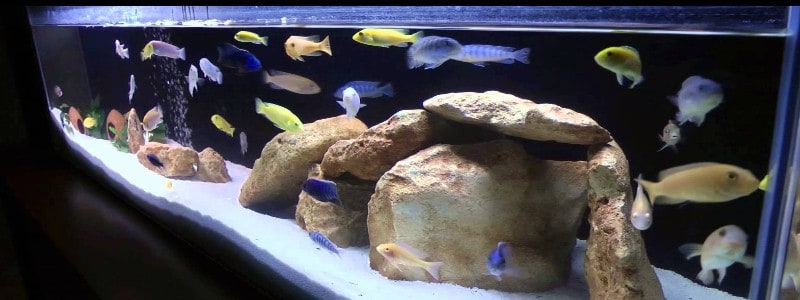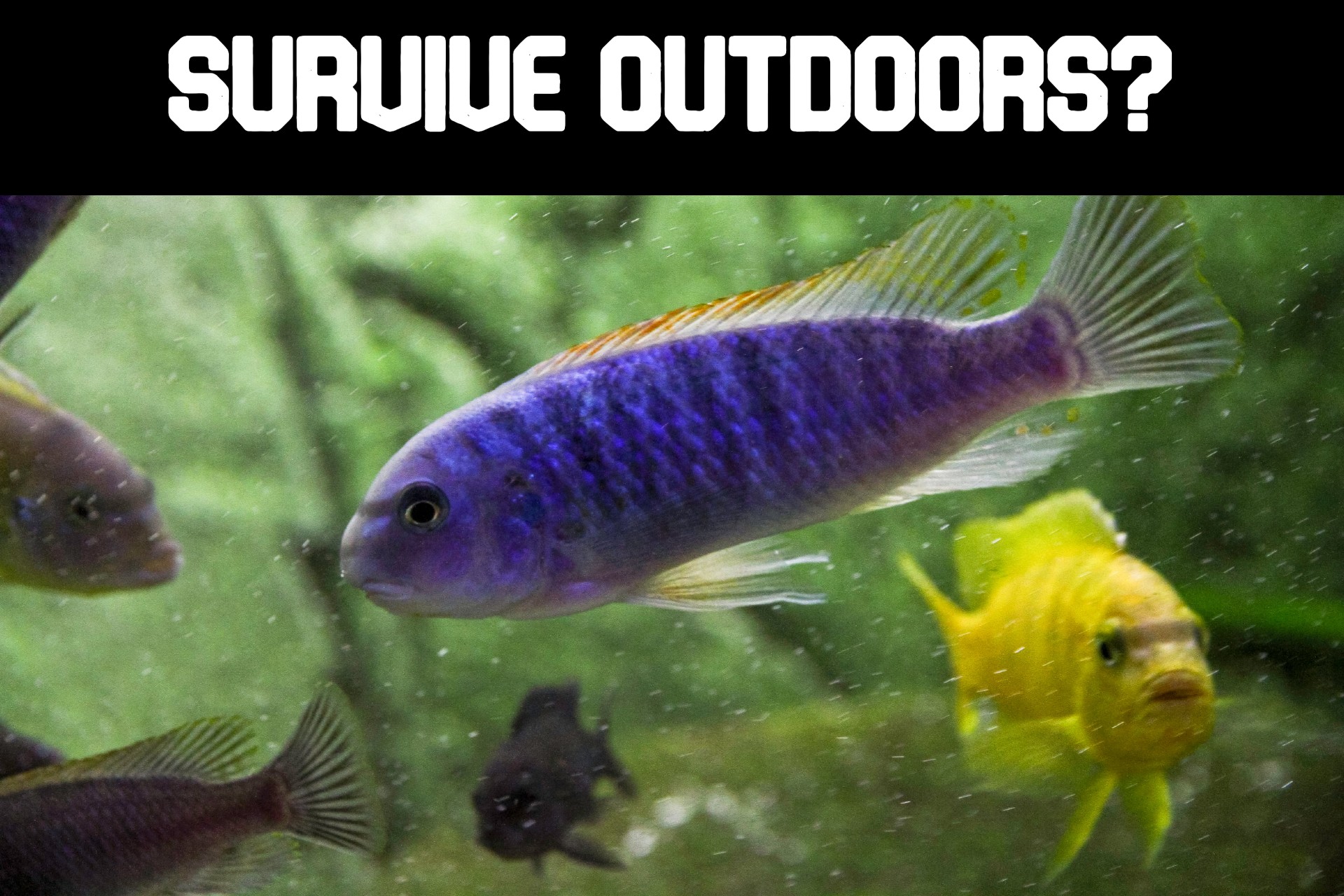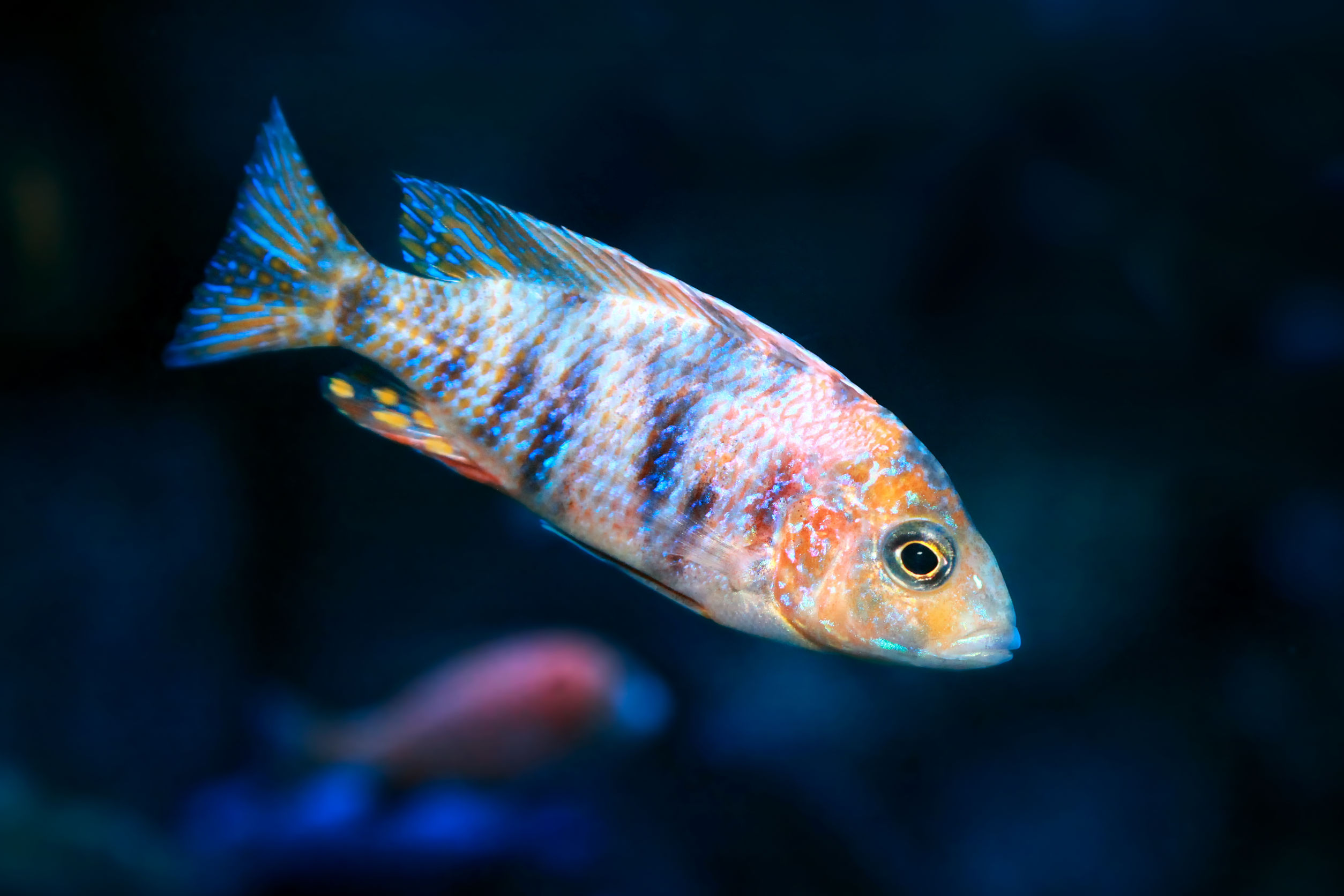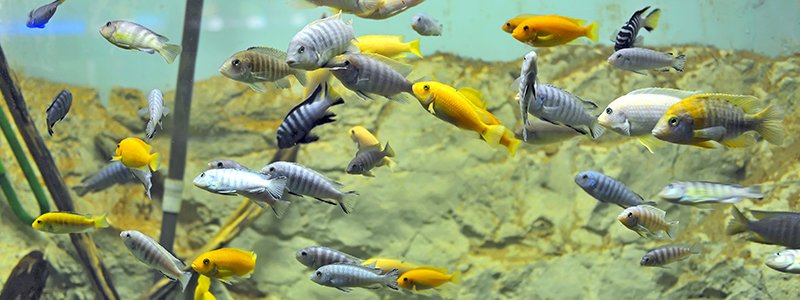Aquarium upkeep for cichlids can be quite involved, but feeding is one of the first things you need to figure out if you’re going to have healthy fish. A well-balanced diet leads to healthy, beautiful fish that live for a lot longer. If you want your cichlids to have a more active life, to look more vibrant, and to live for years, you need to pay attention to what you’re feeding them.
Having quality cichlid food makes a huge difference. Even for fish, the idiom that “you are what you eat” rings true. When cichlids are in the wild, they have highly particular diets that help them live well in their environment. Once you take them to a domestic aquarium (whether they were ever wild or not), you have to think about how to give them all the same positive benefits with a completely different diet. Unless you can exactly replicate their wild environment, you need to find something that works as a substitute.
Luckily, many people enjoy keeping cichlids. Their bright colors and varied species make freshwater aquariums around the world more interesting. Because they’re a popular fish choice, individuals and companies have taken the time to develop food formulas specifically for cichlids. You have a lot more choices, and it’s up to you to learn how to make the right choice for your aquarium full of fish.
How to Choose the Best Cichlid Food
There are three main things you need to know before you look at buying food for cichlids. Not all food is going to have the same nutritional values and the nutrients within won’t be sourced from the same ingredients in every mix. Knowing this, here’s what you should pay specific attention to:
1. Nutrition
Cichlids will vary in their nutritional needs, but in general cichlid food should be high in protein, fiber, and digestible fats. Protein content should be high to help them stay at the peak of their health. Nutrition sources will vary depending on the type of cichlids you keep. Understanding the nutritional needs of your species of fish will help you make a better choice.
Food that’s specially made for cichlids will usually have a good base to work with as far as nutrition is concerned. It may not be exactly what your cichlids need, which may mean some supplements alongside their food, but it’s probably a better choice in a pinch than generic tropical fish foods.
2. Color Enhancement
For vibrant colors, choose foods that are highly pigmented. Red, yellow, and orange-colored cichlids will need higher levels of pigmentation in their food to keep their color brighter. Underwater plants like algae, kelp, seaweed, and some green plants like peas, spinach, or broccoli can all act to enhance the natural color of a cichlid as well.
3. Food Type
Most cichlid foods come as pellets or flakes. Smaller fish do better with flakes, while larger fish can eat either. Pellets tend to sink to the bottom of the tank more quickly, while flakes can disintegrate and cloud the water. Flakes are great when you’re feeding your fish multiple times a day so you can feed little bit of food at a time. Pellets are better for once-a-day feeding for larger fish.
Top 5 Cichlid Foods in the Industry
| Rank | Cichlid Food Name | Type of Food | Amazon Link |
| 1 | Tetra Cichlid Balanced Diet Flakes (Budget-Friendly) | Flakes | Check Price on Amazon |
| 2 | Aqueon Cichlid Pellets | Sinking Pellets | Check Price on Amazon |
| 3 | NewLife Spectrum Cichlid Formula | Sinking Pellets | Check Price on Amazon |
| 4 | Hikari Sinking Cichlid Gold Pellets | Sinking Pellets | Check Price on Amazon |
| 5 | Tetra Cichlid Dual Blend 2-in-1 | Sinking and Floating Pellets | Check Price on Amazon |
1. Tetra Cichlid Balanced Diet Flakes
Pros
- Good size and texture compared to other fish food flakes
- Economy sizes available that offer good value for money
- Flakes will float well at the surface for easier feeding
- Water stays clear even after feedings
Cons
- Not as filling or satisfying for larger fish
- Can clog up an auto-feeder because of varied flake sizes
Available in everything from a 1.58oz box to a 1.75lb container, this cichlid food mix is designed for top and mid-feeding cichlids from around the world. It’s great for African cichlids and can also be used for most American cichlids, though some high protein live food or meat-based food is a good addition for American cichlids that tend to be more carnivorous. The balanced nutrients include a high protein content from quality fish meals and shrimp meals.
A variety of healthy vegetable ingredients are part of the mix as well, providing necessary vitamins and fiber. This cichlid food contains algae meal, ground brown rice, dehulled soybean meal, wheat gluten, dried potato products, cornflower, and more. Colorants are added to help your cichlids take on a brighter shade, especially yellow and blue cichlids. Many of the natural ingredients also contribute to color enhancement.
Tetra’s flake foods are developed with a formula that helps them stay complete while fish are fed. Instead of breaking up into a lot of tiny pieces that can be ignored by fish, they stick together for longer and are slower to disintegrate into water. The result of this formula change is fewer broken-up flake food pieces in the water, giving a cleaner appearance to the tank. Flakes staying together more easily also helps your fish to eat them entirely, getting all the nutrients and filling up more quickly.
2. Aqueon Cichlid Pellets
Pros
- Slow-sinking helps cichlids to eat the pellets more efficiently
- Ingredients provide great value for money
- Good for other fish besides cichlids, provides balanced nutrition for many tropical fish
- Water stays cleaner, pellets do not break up easily unless left for some time
Cons
- The water pump should be turned off before feeding or the pellets may disperse widely
- Pellet size is too small for larger fish to see or eat easily, and might be ignored instead
You can get these Aqueon pellets from 4oz. to 25oz. bags with medium pellets around 2-4mm in size. Other sizes of pellets are sometimes available from mini to large. Their formula is a good base cichlid food that’s appropriate for most types of cichlids. This food is intended mainly for top-feeding fish and it holds good levels of basic nutrition to use as a general cichlid food.
There are no artificial colors added to these pellets. Pigmented ingredients in the formula, like chili powder and marigold powder, help to naturally enhance colors in your fish. Protein is derived from fish meal, dried krill, squid meal, and other plant-based sources. Aqueon’s cichlid pellets have a good balance of essential vitamins and other nutrients along with protein. Krill and squid are considered premium fish food ingredients for nutrition.
When you drop the pellets into the water, they float well for a few minutes. They’re designed as slow-sinking pellets to give the fish optimal time to eat what they want. It’s easy to find the balance of food needed when they stick higher in the water. If you’re overfeeding your fish, pellets may be ignored at the top and will sink down to reach the floor of the tank. Any pellets that reach to bottom may still be eaten by your fish as the day goes on, or a bottom feeder can take care of them instead.
3. NewLife Spectrum Cichlid Formula
Pros
- 1mm size is great for smaller fish, easily eaten in one bite
- The formula helps give cichlids more vibrant colors with continued use
- Great nutrient mix for most cichlids, especially African cichlids
Cons
- Can dirty up the tank if too much sinks to the bottom
- Not good for fish larger than 2-3 inches, size is too small
Available in 250g containers, NewLife Spectrum’s cichlid formula comes with 1mm large sinking pellets. Though it’s designed more with African cichlids in mind, it can also be used as a good starting point for American cichlids. A little extra meat or protein supplemented for American cichlids can create a well-rounded diet for the whole aquarium.
The pellets are rich in plant-based nutrients including algae meal, seaweed, kelp, and extracts from other fruits and vegetables. Ingredients like these help to greatly enhance the natural colors of the fish in your tank, especially your cichlids. Artificial colors are not added to this formula. Alongside the plant-based ingredients, there are also protein-rich Antarctic krill and whole herring in the mix to meet the dietary needs of a variety of cichlids.
Because these are sinking pellets, they’re best for cichlid species that are willing to eat off of the bottom of the tank. The pellets may float for a short time while they soak up water, but they will sink quickly and remain around the bottom of the tank for your fish to eat as they go. It’s good food for cichlids that eat quickly or for a mix of bottom-feeding fish and cichlids. Larger fish may ignore these pellets because of their smaller size, which can be an advantage if you’re intended to feed bottom-feeders, but it won’t help if you have larger cichlids to feed.
4. Hikari Sinking Cichlid Gold Pellets
Pros
- Helps to enhance the natural colors of your cichlids and other tropical fish
- Nutrition blend gives fish the right stuff to grow large
- Great size for older and larger tropical fish
- Good source of fiber and other essential vitamins for your fish
- Value for money compared to other top brands of pellet cichlid foods
Cons
- Pellets dissolve faster than many floating pellets, making water dirtier
- Fish meal is the main protein source, not whole fish or krill
You can find these pellets in 12oz bags, with the option to purchase a 1 or 2-pack at a time. The pellets themselves are medium-sized, meant for medium to large cichlids or other tropical fish. Most cichlids can get their basic nutrition from this food, though some meat-based protein supplements may be necessary for carnivorous species.
The ingredients in the Hikari Cichlid gold pellets are high-quality fish and plant-based ingredients. With a hearty combination of fish meal, wheat bran and flour, corn, and a variety of added vitamins and vital nutrients, these pellets provide a good base for your feeding routine. Color enhancements ingredients and artificial coloring help to bring out the brightest colors for your cichlids. Added astaxanthin boosts your cichlids’ immune health and aids in preventing disease.
Designed as sinking pellets, they’re a great fit for fish that eat quickly or who will eat from the bottom of the tank. As they sink, the pellets are designed to stay together well instead of breaking apart immediately and clouding up the aquarium water. Their large, rounded size (not circular) makes these pellets easy to eat and digest. Because they sink quickly, these are good pellets to share between bottom feeders and cichlids or other tropical fish.
5. Tetra Cichlid Dual Blend 2-in-1
Pros
- Works well to enhance colors in your fish, especially orange, yellow, and red
- Suits aggressive and passive fish, top and bottom feeders
- Good pellet to serve with live food as a supplementary protein source
- Suitable for small and medium fish
Cons
- More floating pellets are included in the bag, sticks settle at the bottom of the bag
- The main ingredients are wheat flour and wheat gluten rather than a protein source
This blend from Tetra caters to different types of fish by mixing both sinking floating pieces in the same bag. Both types of pieces are made with the same nutritious formula but are designed to suit different varieties of fish. The bag contains 4.8oz. of mixed pellets and sticks that are intended for cichlids of all kinds. A balanced blend of nutrients is supplied to act as a strong dietary choice for African and American cichlids alike, as well as other tropical fish.
Protein in this Tetra dual blend food comes primarily from fish meal, shrimp meal, and potatoes. Wheat flour, wheat gluten, dried yeast, soybean oil, and a long list of added vitamins and nutrients combine together to create a solid dietary staple for your cichlids. Color-enhancing ingredients bring out the best in your cichlids by brightening their existing colors to make them appear more vivid.
With two different types of pellets come different sizes as well. The floating pellets are larger, making them more appropriate for medium to large fish. Sinking stick pieces are smaller than the pellets and easily ingestible by many young or small cichlids. Instead of using two different sizes of fish food for your aquarium, this is a good compromise option to feed different sizes of fish all at once. You can also suit bottom feeders and top or mid-feeders, making it a good solution for aquariums containing a lot of different tropical fish species.

Cichlid Food Buyer’s Guide
What else is important to tell the difference in cichlid food quality? There are a lot of different options on the market, so you have to pay attention if you want to get the right mix for your aquarium. Read a few more tips to help you make the right choice:
1. Cichlid Varieties Eat Differently
There are huge differences in the eating habits of different species of cichlids. African cichlids alone contain species of omnivores, carnivores, herbivores, and micro-predators. American cichlids also have varied dietary needs based on their species. If you have one type of cichlid only, it’s easy enough to find the right food for them. If you’re mixing different species of cichlids, research to understand the dietary needs of each species so you can create a good balance of nutrients.
If you buy a good meant for African cichlids and feed it to American cichlids, you may not be covering all the nutritional needs of your fish. Some species of cichlids are quite particular, so you need to pay attention to their exact needs and not assume that one cichlid food will work for all species of cichlids. Even cichlids that live in the same environment in the wild do not always eat the same types of food!
2. Food Affects Growth
What you feed your cichlids can directly impact their growth. If you want them to grow larger, protein is a necessary staple of their diet. Choose foods that are high in varied sources of protein, or supplement their diet with extra protein from other sources.
3. Avoid Fatty Foods (Beef Heart)
Cichlids are cold-blooded animals. Fatty foods from warm-blooded animals do not metabolize the right way and can build up in the liver. A buildup of unusable fats in the liver may cause cirrhosis, a potentially deadly disease. Beef heart is recommended by some for speeding up cichlid growth, but it may not be a good option if you’re concerned about creating health problems. Avoid warm-blooded animal fats in al cichlid foods if possible, including beef heart, for a healthier diet.
4. Mixing Foods
Many aquarium care experts recommend a varied diet, even if you only have a single variety of cichlid. Mix some flakes or pellets with fresh vegetation, live food, or frozen food. Variation will help your cichlids get all the nutrition they need from different sources and will help them to continue each well. Even with the best cichlid food, there’s no option that can perfectly simulate their wild eating habits. You can provide a few different foods to ensure they’re eating all they need.
5. Vitamins and Other Vital Nutrients
A lot of vitamins, minerals, and trace nutrients can improve the overall health of your cichlids. It’s an added bonus for your selected food to include a good mix of vitamins. The right balance of nutrients can boost your cichlids’ immune systems, enhance their natural colors, improve their growth, and keep them resistant to common diseases.
Frequently Asked Questions
How often do I feed my cichlids?
It depends more on your schedule than anything else. If you want to feed them once per day, you can do that as long as you feed them the right amount of food. Feeding 2-3 times per day in smaller amounts can help you pace your fish a bit better and allow them to digest the food easily. Multiple daily feedings can also help with aggression in cichlids because much of their aggression stems from fighting over food.
How much food do cichlids need?
There’s no set amount to give to your fish. Instead, focus on giving them only what they can reasonably eat within 2 minutes (if you’re feeding once daily). There shouldn’t be leftover food floating around in the tank after they eat. Even if you have good filtration if you don’t remove uneaten food you’re putting your water quality in jeopardy. Only feed your fish when they’re hungry, and choose the side of underfeeding rather than overfeeding until you get a feel for how much they need.
Can I use an automatic feeder for cichlids?
If you’re going on vacation, you can use an automatic feeder to give your cichlids their daily meal. It might be better if you can have someone come to care for your aquarium while you’re gone so they can more easily monitor the amount of food your fish are eating.
Why are my cichlids losing their bright colors?
Like most fish, cichlids can lose their vivid colors when they’re either not getting the right nutrients in their diet or they’re experiencing stressful conditions. Always test your water conditions first to see if water quality is causing your fish stress, then move on to other potential causes, such as dietary issues or disease. Some dietary supplements can help to return their color to normal.
Conclusion
Finding the best cichlid food shouldn’t be stressful for you. Make sure you understand what your particular fish needs and learn about what differentiates one food from another. Take your knowledge and find the best fit for your lifestyle and your cichlid aquarium.





